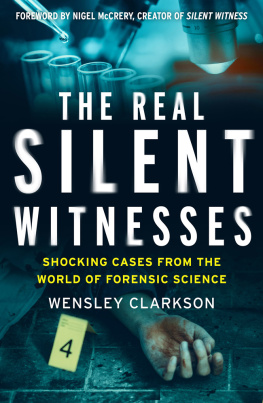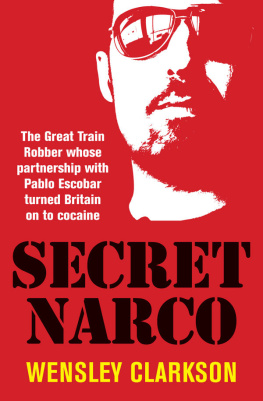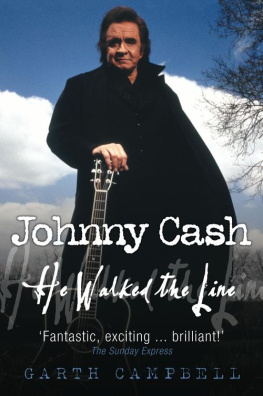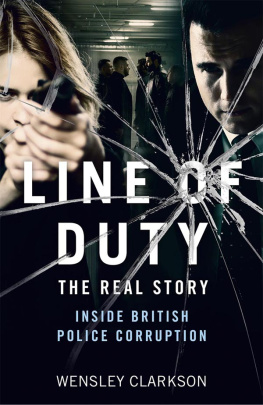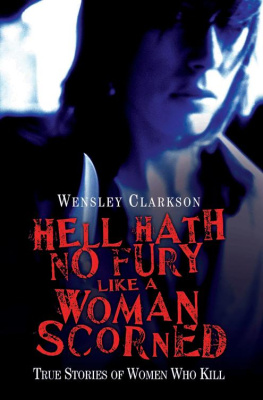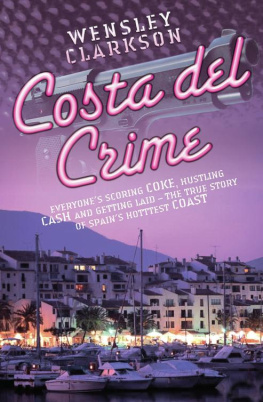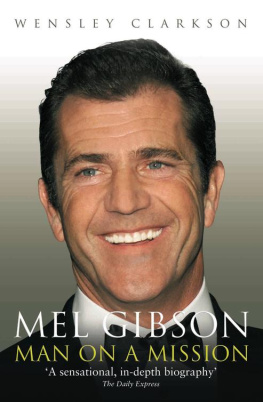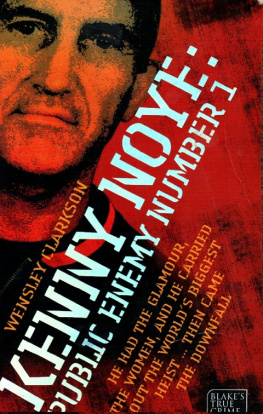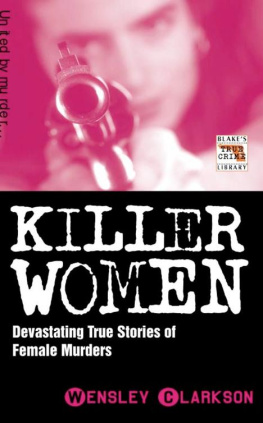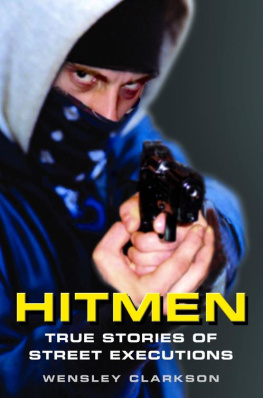Wensley Clarkson - The Real Silent Witnesses
Here you can read online Wensley Clarkson - The Real Silent Witnesses full text of the book (entire story) in english for free. Download pdf and epub, get meaning, cover and reviews about this ebook. year: 2021, publisher: Welbeck Publishing Group Limited, genre: Detective and thriller. Description of the work, (preface) as well as reviews are available. Best literature library LitArk.com created for fans of good reading and offers a wide selection of genres:
Romance novel
Science fiction
Adventure
Detective
Science
History
Home and family
Prose
Art
Politics
Computer
Non-fiction
Religion
Business
Children
Humor
Choose a favorite category and find really read worthwhile books. Enjoy immersion in the world of imagination, feel the emotions of the characters or learn something new for yourself, make an fascinating discovery.
- Book:The Real Silent Witnesses
- Author:
- Publisher:Welbeck Publishing Group Limited
- Genre:
- Year:2021
- Rating:3 / 5
- Favourites:Add to favourites
- Your mark:
- 60
- 1
- 2
- 3
- 4
- 5
The Real Silent Witnesses: summary, description and annotation
We offer to read an annotation, description, summary or preface (depends on what the author of the book "The Real Silent Witnesses" wrote himself). If you haven't found the necessary information about the book — write in the comments, we will try to find it.
The Real Silent Witnesses — read online for free the complete book (whole text) full work
Below is the text of the book, divided by pages. System saving the place of the last page read, allows you to conveniently read the book "The Real Silent Witnesses" online for free, without having to search again every time where you left off. Put a bookmark, and you can go to the page where you finished reading at any time.
Font size:
Interval:
Bookmark:


CONTENTS
By Nigel McCrery, creator of Silent Witness
As a writer, I am probably better known for my works of fiction, like the BBC series Silent Witness and New Tricks. However, before becoming a writer I served as a police officer in Nottinghamshire, dealing with crimes of every nature, from murder to burglary. As this book rightly points out, it is from many of these true-life crimes and the people I encountered while dealing with them that I drew inspiration for many of my fictional characters and stories.
Probably the best known of these is the Home Office pathologist Professor Helen Whitwell. Helen is without doubt one of the brightest people I have ever met, writing several books on her subject, including Masons Forensic Medicine for Lawyers. During her long and illustrious career, Helen worked for both the prosecution and the defence and became one of the worlds leading experts on Shaken Baby Syndrome. Yet despite her outstanding academic qualifications, she is certainly not like the nerdy boffins normally associated with the job. An elegant woman in every respect, she enjoys champagne breakfasts, fine dining and high-quality wines and spirits. Yet there is a slightly eccentric side to Helen which made her interesting and the perfect character for any work of forensic fiction; I certainly could never have made Helen up. She would get lost en route to murder scenes and, before the age of the infamous mobile phone, would call the control room, give them the number she was calling from, and the investigating officers would have to send a car and a detective to find her and bring her to the location. On another occasion, during the early hours of the morning, she arrived at the murder scene after the press and TV cameras. Reversing up an unknown persons drive, she opened her bag, which I thought would be full of the tools of her trade: a scalpel and bottles of various sizes and uses. Instead of producing those, she produced a make-up bag, hairbrush and perfume, announcing that if we thought she was going to face the press at 3 a.m. without her slap on, we could think again. When she had examined herself thoroughly, we moved on to the scene. Probably my favourite characteristic, however, was her heavily scented garden, each plant and flower selected for its particular aroma. I hadnt realized she was such a keen gardener and told her so. To my surprise, she replied that she wasnt: in fact, she didnt really enjoy gardening. So, I pointed out, why the beautiful garden? Her reply was both interesting and surprising. Pathologists are famous for losing their sense of smell. Its not the pungent and often putrefying smell of the bodies but the chemicals used during the examinations that can damage your senses. As soon as she could no longer smell her garden, or the strong aromas dimmed, she would retire. Some years later, she did.
New Tricks was once again based partially on characters I had met, and often worked with, during my service. Many of the more bizarre incidents and storylines were also based on things I had witnessed or been involved with. As a reader as well as a writer of crime fiction, it became clear very quickly that, as is well illustrated in this book, fiction only illustrates and at times illuminates crime, but nothing comes close to truly representing it, as human emotions and the motives of the individual, however odd and unfathomable, drive an investigation forward.
As suspects become more aware of their rights within the law, the job of the detective has become increasingly difficult. Many, especially professional criminals, will refuse to say a word, relying on phrases such as no comment the standard reply recommended by defence solicitors. Eyewitness evidence is also often, under cross-examination, being brought into question and uncertainty. As a result of this, forensic science plays an ever more significant role in delivering important evidence to the attention of a jury or magistrate of a kind that is increasingly difficult to refute or challenge.
Using forensic science within a criminal investigation is basically about identification. Forensic investigation is concerned primarily with piecing together the disparate clues left at a scene in order to form a coherent picture of events and, crucially, to establish the identities of those involved or, equally importantly, those who were not. The anthropologist Margaret Mead (190178) said, Always remember that you are absolutely unique. Just like everybody else. It is within this uniqueness of the individual that forensic science is based and thrives. Alphonse Bertillon (18531914), the French scientist and criminologist, pioneered not only the use of photographs and a basic method of photo-fit but also established a method of identification based on a persons unique measurements: length of nose, fingers, arms, feet, et cetera. He calculated that if eleven measurements on an individual matched eleven on the suspect, the chances of them not being the guilty person was four million to one. After initial struggles within a doubting scientific community, he was hailed as the greatest criminologist of his day. However, following his failure to trace the criminal who had stolen the Mona Lisa, despite a large palm print being found on the glass that had covered the painting, his methods, while not entirely dismissed, were largely discredited. From then on, the science of fingerprinting started to gather traction.
Today we live in the age of DNA, a process of identification which was honed by the scientists Sir Alex Jeffrey and Peter Gill while researching at Leicester University. This method was first used to solve the Narborough Murders, when it led not only to the discovery of Colin Pitchfork, the killer of two teenage girls, Lynda Mann and Dawn Ashworth, but to the exoneration of the polices main suspect, who was subsequently released. DNA has now been used to solve thousands of crimes, both recent and historic, as it continues to be refined.
Writers of fiction will continue to use forensic science as a method of leading their fascinated readers towards their hidden culprit. They seldom have to cope with the everyday realities of a complicated and often drawn-out enquiry. Real investigators, as illustrated in this book, do not have the privileges of fiction. They have to work within legal limits, budgets and what, in reality, forensic science is genuinely capable of. In fiction, cost fails to be an issue, and if the science doesnt quite work, well, you can always stretch a point. In many ways, true crime illustrates far better the work of an investigating team and their interaction with forensic science. Its this interaction that makes The Real Silent Witnesses one of the most fascinating books on the subject.
My patients never complain.
If their illness is perplexing,
I can always put them back
in the refrigerator.
KEITH SIMPSON,
LEGENDARY BRITISH FORENSIC SCIENTIST.
SILENT WITNESS
A LEGAL DEFINITION
A theory or rule in the law of evidence that is produced by a process whose reliability is established and may be admitted as substantive evidence of what it depicts, without the need for an eyewitness to verify the accuracy of its depiction.
The heroes and heroines of this book are without doubt the forensic scientists. So to any whom I have failed to mention here, I humbly apologize. Your skills have not gone unnoticed. I simply dont have enough room in this book to highlight all your successes!
Font size:
Interval:
Bookmark:
Similar books «The Real Silent Witnesses»
Look at similar books to The Real Silent Witnesses. We have selected literature similar in name and meaning in the hope of providing readers with more options to find new, interesting, not yet read works.
Discussion, reviews of the book The Real Silent Witnesses and just readers' own opinions. Leave your comments, write what you think about the work, its meaning or the main characters. Specify what exactly you liked and what you didn't like, and why you think so.

